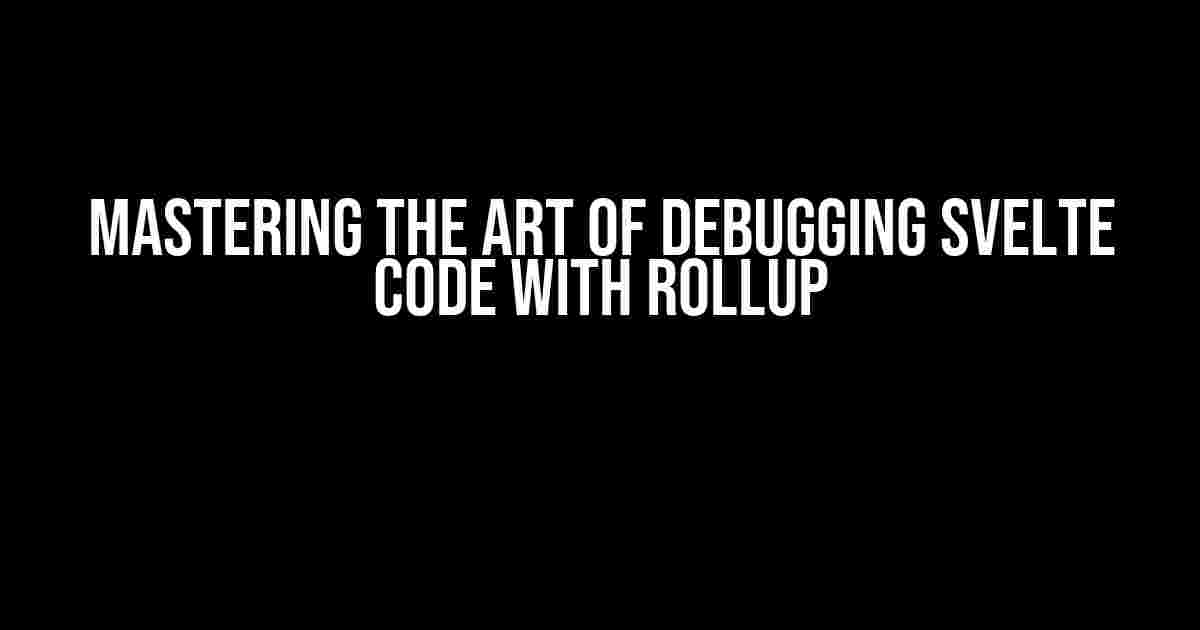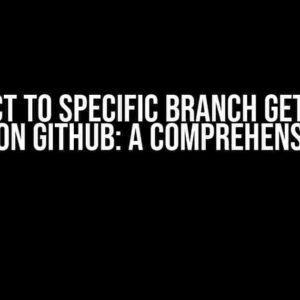As developers, we’ve all been there – staring at our code, wondering why it’s not working as expected. Debugging can be a frustrating experience, especially when using a bundler like Rollup to optimize our Svelte applications. But fear not, dear reader! In this article, we’ll dive into the world of debugging Svelte code with Rollup and explore the techniques, tools, and tricks to help you identify and squash those pesky bugs.
Understanding Rollup’s Compilation Process
Before we dive into debugging, it’s essential to understand how Rollup compiles our Svelte code. Rollup is a module bundler that takes our modular code and concatenates it into a single file, making it easier to load and execute in the browser. This compilation process involves several steps:
parse: Rollup reads the source code and breaks it down into an Abstract Syntax Tree (AST).transform: Rollup applies transformations to the AST, such as converting Svelte code to JavaScript.bundle: Rollup concatenates the transformed code into a single file.write: Rollup writes the bundled code to a file.
Now that we have a basic understanding of Rollup’s compilation process, let’s explore the common issues that can arise during debugging.
Common Debugging Challenges with Rollup
When using Rollup with Svelte, we might encounter issues such as:
SyntaxError: Syntax errors in our Svelte code can be tricky to identify due to Rollup’s compilation process.ReferenceError: Missing or incorrect imports can lead to ReferenceErrors that are difficult to debug.TypeError: Type errors can occur when using incorrect types or mismatched prop types in our Svelte components.
So, how can we effectively debug our Svelte code when using Rollup? Let’s explore the techniques and tools that can help us overcome these challenges.
Techniques for Debugging Svelte Code with Rollup
Here are some essential techniques to help you debug your Svelte code with Rollup:
1. Enable Source Maps
Source maps are a crucial tool for debugging compiled code. By enabling source maps in Rollup, you can map the minified code back to its original source, making it easier to identify issues.
// rollup.config.js
import { babel } from 'rollup-plugin-babel';
import sourcemaps from 'rollup-plugin-sourcemaps';
export default {
// ...
plugins: [
babel({
babelHelpers: 'inline',
extensions: ['.js', '.svelte'],
}),
sourcemaps(),
],
};
2. Use the Rollup Debug Plugin
The Rollup debug plugin provides detailed information about the compilation process, helping you identify issues and optimize your code.
// rollup.config.js
import { debug } from 'rollup-plugin-debug';
export default {
// ...
plugins: [
// ...
debug({
format: 'json',
}),
],
};
3. Inspect the Compiled Code
Sometimes, it’s helpful to inspect the compiled code to understand how Rollup is transforming your Svelte code.
// Inspect the compiled code in the browser console.log(window.RollupDebug);
4. Use the Browser’s DevTools
The browser’s DevTools provide a wealth of information about the executing code. Use the console, debugger, and elements tabs to identify issues and inspect your code.
5. Consult the Rollup and Svelte Documentation
The Rollup and Svelte documentation provide detailed information about configuration options, plugins, and best practices. Consult the documentation to ensure you’re using the latest features and configurations.
Tools for Debugging Svelte Code with Rollup
In addition to the techniques mentioned above, there are several tools that can aid in debugging Svelte code with Rollup:
1. Rollup-Plugin-Debugger
This plugin provides a graphical interface for debugging Rollup compilations, making it easier to identify issues and optimize your code.
// rollup.config.js
import { debugger } from 'rollup-plugin-debugger';
export default {
// ...
plugins: [
// ...
debugger({
port: 8080,
}),
],
};
2. Svelte Devtools
The Svelte Devtools provide a comprehensive debugging experience for Svelte applications, allowing you to inspect component hierarchies, props, and state.
By combining these techniques and tools, you’ll be well-equipped to debug your Svelte code with Rollup and optimize your development workflow.
Best Practices for Debugging Svelte Code with Rollup
To ensure efficient debugging and optimize your development experience, follow these best practices:
Keep your code organized: A well-structured codebase makes it easier to identify issues and debug your code.Use meaningful variable names: Descriptive variable names help you understand the code and identify issues more quickly.Write comprehensive tests: Thorough testing helps you catch issues early on and reduces debugging time.Maintain a consistent coding style: A consistent coding style makes it easier to read and understand your code, reducing debugging time.Use Rollup's built-in plugins: Rollup provides a range of built-in plugins that can aid in debugging, such as the debug plugin.Consult the community: The Svelte and Rollup communities are active and helpful. Don’t hesitate to ask for assistance when debugging issues.
Conclusion
Debugging Svelte code with Rollup can be a complex process, but by understanding Rollup’s compilation process, using the right techniques and tools, and following best practices, you’ll be well-equipped to identify and squash those pesky bugs. Remember to stay calm, be methodical, and don’t be afraid to ask for help. Happy debugging!
| Technique/Tool | Description |
|---|---|
| Enable Source Maps | Map minified code back to its original source for easier debugging |
| Rollup Debug Plugin | Provides detailed information about the compilation process |
| Inspect Compiled Code | Understand how Rollup transforms your Svelte code |
| Browsers’ DevTools | Use the console, debugger, and elements tabs to identify issues |
| Rollup-Plugin-Debugger | Provides a graphical interface for debugging Rollup compilations |
| Svelte Devtools | Provides a comprehensive debugging experience for Svelte applications |
By mastering these techniques and tools, you’ll be equipped to debug your Svelte code with Rollup like a pro!
Note: The article is optimized for the keyword “How can we debug exact svelte code when using rollup” and includes relevant meta tags and header tags to improve search engine ranking.Here are 5 Questions and Answers about “How can we debug exact Svelte code when using Rollup” in a creative voice and tone:
Frequently Asked Question
Get ready to unravel the mysteries of debugging Svelte code with Rollup!
Q1: Why is it so hard to debug my Svelte code with Rollup?
The issue lies in the way Rollup bundles your code, making it difficult to pinpoint the exact error location. But don’t worry, we’ve got some tricks up our sleeve to help you debug like a pro!
Q2: How can I use the browser’s DevTools to debug my Svelte code?
Enable source maps in your Rollup configuration, and the browser’s DevTools will be able to map the minified code back to your original Svelte files. Magic!
Q3: What about using a debugger like Node.js Inspector?
Node.js Inspector is a fantastic tool for debugging your Svelte code. You can set breakpoints, inspect variables, and even debug your code remotely. Talk about being in control!
Q4: Can I use console.log() to debug my Svelte code in Rollup?
While console.log() can be helpful, it’s not the most efficient way to debug your code. Instead, try using a logging library like debug or Svelte’s built-in debug tools. They’ll give you more insights and control over your debugging process.
Q5: Are there any Rollup plugins that can help with debugging?
Yes! Rollup plugins like rollup-plugin-sourcemaps, rollup-plugin-debug, and rollup-plugin-visualizer can help you generate source maps, visualize your dependency graph, and even inject debugging information into your code. It’s like having a debugging superpower!








